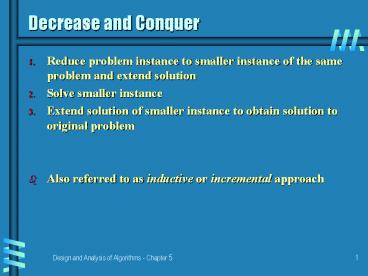Decrease and Conquer - PowerPoint PPT Presentation
Title:
Decrease and Conquer
Description:
Reduce problem instance to smaller instance of the same problem and ... plankton. tiger. Order them so that they don't have to wait for any of their food ... – PowerPoint PPT presentation
Number of Views:300
Avg rating:3.0/5.0
Title: Decrease and Conquer
1
Decrease and Conquer
- Reduce problem instance to smaller instance of
the same problem and extend solution - Solve smaller instance
- Extend solution of smaller instance to obtain
solution to original problem - Also referred to as inductive or incremental
approach
2
Examples of Decrease and Conquer
- Decrease by one
- Insertion sort
- Graph search algorithms
- DFS
- BFS
- Topological sorting
- Algorithms for generating permutations, subsets
- Decrease by a constant factor
- Binary search
- Fake-coin problems
- multiplication à la russe
- Josephus problem
- Variable-size decrease
- Euclids algorithm
- Selection by partition
3
Whats the difference?
- Consider the problem of exponentiation Compute
an - Brute Force
- Divide and conquer
- Decrease by one
- Decrease by constant factor
4
Graph Traversal
- Many problems require processing all graph
vertices in systematic fashion - Graph traversal algorithms
- Depth-first search
- Breadth-first search
5
Depth-first search
- Explore graph always moving away from last
visited vertex - Similar to preorder tree traversals
- Pseudocode for Depth-first-search of graph
G(V,E) - DFS(G)
- count 0
- mark each vertex with 0 (unvisited)
- for each vertex v? V do
- if v is marked with 0
- dfs(v)
- dfs(v)
- count count 1
- mark v with count
- for each vertex w adjacent to v do
- if w is marked with 0
- dfs(w)
6
Example undirected graph
- Depth-first traversal
7
Types of edges
- Tree edges edges comprising forest
- Back edges edges to ancestor nodes
- Forward edges edges to descendants (digraphs
only) - Cross edges none of the above
8
Example directed graph
a
b
c
d
e
f
g
h
- Depth-first traversal
9
Depth-first search Notes
- DFS can be implemented with graphs represented
as - Adjacency matrices T(V2)
- Adjacency linked lists T(VE)
- Yields two distinct ordering of vertices
- preorder as vertices are first encountered
(pushed onto stack) - postorder as vertices become dead-ends (popped
off stack) - Applications
- checking connectivity, finding connected
components - checking acyclicity
- searching state-space of problems for solution
(AI)
10
Breadth-first search
- Explore graph moving across to all the neighbors
of last visited vertex - Similar to level-by-level tree traversals
- Instead of a stack, breadth-first uses queue
- Applications same as DFS, but can also find
paths from a vertex to all other vertices with
the smallest number of edges
11
Breadth-first search algorithm
BFS(G) count 0 mark each vertex with 0 for each
vertex v? V do bfs(v)
- bfs(v)
- count count 1
- mark v with count
- initialize queue with v
- while queue is not empty do
- a front of queue
- for each vertex w adjacent to a do
- if w is marked with 0
- count count 1
- mark w with count
- add w to the end of the queue
- remove a from the front of the queue
12
Example undirected graph
- Breadth-first traversal
13
Example directed graph
a
b
c
d
e
f
g
h
- Breadth-first traversal
14
Breadth-first search Notes
- BFS has same efficiency as DFS and can be
implemented with graphs represented as - Adjacency matrices T(V2)
- Adjacency linked lists T(VE)
- Yields single ordering of vertices (order
added/deleted from queue is the same)
15
Directed acyclic graph (dag)
- A directed graph with no cycles
- Arise in modeling many problems, eg
- prerequisite structure
- food chains
- Imply partial ordering on the domain
16
Topological sorting
- Problem find a total order consistent with a
partial order - Example
tiger
Order them so that they dont have to wait for
any of their food (i.e., from lower to higher,
consistent with food chain)
human
fish
sheep
shrimp
NB problem is solvable iff graph is dag
wheat
plankton
17
Topological sorting Algorithms
- DFS-based algorithm
- DFS traversal noting order vertices are popped
off stack - Reverse order solves topological sorting
- Back edges encountered?? NOT a dag!
- Source removal algorithm
- Repeatedly identify and remove a source vertex,
ie, a vertex that has no incoming edges - Both T(VE) using adjacency linked lists
18
Variable-size-decrease Binary search trees
- Arrange keys in a binary tree with the binary
search tree property
Example 1 5, 10, 3, 1, 7, 12, 9 Example 2 4,
5, 7, 2, 1, 3, 6
k
ltk
gtk
- What about repeated keys?
19
Searching and insertion in binary search trees
- Searching straightforward
- Insertion search for key, insert at leaf where
search terminated - All operations worst case key comparisons h
1 - lg n h n 1 with average (random files)
1.41 lg n - Thus all operations have
- worst case T(n)
- average case T(lgn)
- Bonus inorder traversal produces sorted list
(treesort)































